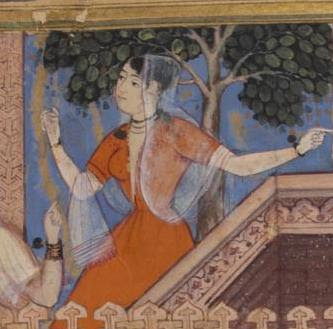Here's the illumination in question.
The description:
In 1564, the Mughal emperor Akbar visited the house of a man called Khwaja Mu’azzam. At a time when Mughal authority was frequently challenged, rebellions broke out frequently and occasional attempts were made on Akbar's life. On this occasion, Akbar sensed that one of the Khwaja’s Gujarati servants was about to kill him. He swiftly ordered one of his own men, Qutlaq Qadam Khan, to strike first. The unnamed artists who designed the composition and applied the colours vividly depict the incident described in the Persian text . The would-be attacker was instantly decapitated and, in the words of Henry Beveridge's English translation, ‘for a moment the trunk remained standing and the black blood spouted from the arteries of the neck’. The event took place in 1564, and was illustrated in this partial copy of the text written by Abu'l Fazl between about 1590 and 1595. On the reverse is another painting (IS.2:38-1896) thought to be by the same, unidentified artist.
Now, that's a pretty gorey explanation for an illumination, but apt. The first thing that caught my attention was the guy drawn outside the space - which I may incorporate into future illuminations of my own. But then I saw all the women upstairs.
Note the top quarter of the illumination.
There's a lot going on here. But what I'm noticing is, except for the lady in the hat, everyone's neckline plunges below the breast.
That hat is shorter and seems built over a folded frame, and I'll probably attempt that soon. She's wearing the older woman's robe with the covered hand sleeves, so I suspect she is married. The other ladies at first appear to be wearing short, tight-cap sleeves with lots of jewelry. But man, look at those necklines.
Because of the artist's lines, I can't tell if those are puckers in the fabric, jewelry or patterning. But boy, there's no question about how far that neckline does down.
So my question is, is this a foldover dress? Or is it tucked at the waist? What's going on here?
A later manuscript depicting, of all things, the presentation of the Christ 40 days after his birth.
The interpretation:
Contact between Europe and the Mughals began in 1573, when the emperor Akbar (r. 1556-1605) led his forces into Gujarat and captured the great port city of Surat. Here, he encountered Westerners for the first time. They were from the Portuguese settlement of Goa to the south, and as a result of this meeting Akbar decided to send an embassy to Goa. This led in 1582 to the first of several Jesuit missions from Goa to the Mughal court. The Jesuits brought prints and paintings that were shown to the royal artists, who began to copy or adapt elements from them. This scene may be based on a depiction of the presentation of the infant Jesus in the temple at Jerusalem, forty days after his birth. It probably dates to ca.1600-1610, and was formerly in the collection of Arthur Churchill, from whom the museum bought it in 1913.
So here's a similar dress, worn OVER a chemise.
Okay, so what's up with pinchy boobs?
This overdress is full length and still has the gathers. I'm not convinced those gathers aren't a peticoat string, but they are awful uniform.









No comments:
Post a Comment